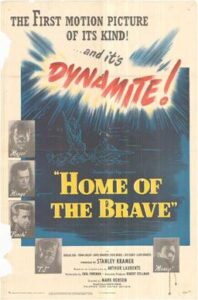Home of the Brave **** (1949, Frank Lovejoy, Lloyd Bridges, Douglas Dick, James Edwards, Steve Brodie, Jeff Corey, Cliff Clark) – Classic Movie Review 12,980
The 1949 American war drama Home of the Brave is one of the first films about anti-Black racism, though adapted from a play by Arthur Laurents about anti-Semitism in the US Army.
Director Mark Robson’s 1949 American war drama film Home of the Brave is one of the first films about anti-Black racism, and stars Frank Lovejoy, Lloyd Bridges, Douglas Dick, James Edwards, Steve Brodie, Jeff Corey, and Cliff Clark. The story is adapted from a play by Arthur Laurents about anti-Semitism in the US Army, but changed into a film about the persecution of a Black soldier.
This notable, honourable early film about the scourge of anti-Black racist prejudice is one of Hollywood’s first, tentative attempts to focus on America’s troubled race relations. A complex film, it combines the war movie, the psychological drama, and the troubles faced by African-Americans.
A Black soldier, war veteran Private Peter Moss (James Edwards), who becomes paralysed through shock, narrates his story to an Army psychiatrist (Jeff Corey) about how he suffered racist abuse from his World War Two army buddies, particularly the bigoted Corporal T J (Steve Brodie), on a reconnaissance mission on a South Pacific Japanese-held island. Racial tensions arise between the white soldiers and the only black member of the platoon.
Its intriguing, quite challenging story about prejudice may lack today’s freshness and vigour, but it is still capable of keeping audiences to attention with an intelligent story and a historical perspective on a serious issue.
There is a wealth of good acting, especially from Edwards, Lloyd Bridges as his buddy, Douglas Dick as the major and Frank Loveloy as the sergeant. But there is disappointingly uncinematic filming by director Robson of a stage play (by Arthur Laurents) that was actually about anti-Semitism in the US military, with the main character being Jewish.
It is Bridges’s first starring role in a major movie.
The title is of course from the last line of the Star Spangled Banner: ‘And the home of the brave’.
Kramer filmed in secrecy, supposedly under the working title of High Noon, which is the title of his later classic.
Jewish writer Arthur Laurents became a sergeant with the Army Pictorial Service based at the film studio in Astoria, Queens, spent World War Two. Later he wrote his play Home of the Brave in nine consecutive nights, inspired by a photograph of GIs in a South Pacific jungle. It opened on Broadway on December 27, 1945, and ran for 69 performances.
Laurents was told that the lead character would be turned from Jewish into Black in the film version because ‘Jews have been done’.
It was shot in 30 days for $525,000 using three different units simultaneously. Most of the film is shot on indoor sets, with jungle scenes in Baldwin Village, Los Angeles, and the climax on Malibu beach with a former navy PT boat.
Robert Stillman financed the film with the help of his father, without borrowing from banks. It earned $2.5 million at the box office so that was a good move, though risky.
Supposedly, Herbert Tweedy imitated the sounds of 12 kinds of South Pacific birds.
Home of the Brave is directed by Mark Robson, runs 87 minutes, is made by Stanley Kramer Productions and Screen Plays, is released by United Artists, is written by Carl Foreman, is shot in black and white by Robert de Grasse, is produced by Stanley Kramer and Robert Stillman (associate producer), is scored by Dimitri Tiomkin, and is designed by Rudolph Sternad.
Release date: May 12, 1949 (US).
The cast are Jeff Corey as Doctor, James Edwards as Private Peter Moss, Lloyd Bridges as Finch, Douglas Dick as Major Robinson, Frank Lovejoy as Sergeant Mingo, Steve Brodie as T J Everett, and Cliff Clark as Colonel Baker.
James Edwards (March 6, 1918 – January 4, 1970) was commissioned as a first lieutenant in the US Army in World War Two. Home of the Brave is his second released film after The Set-Up (1949). He often played African American soldiers, and worked busily, but Private Peter Moss is his most famous role.
Soon there was trouble with the House Un-American Activities Committee, including for James Edwards. It is believed he was cast in Red Ball Express (1952) but was replaced by Sidney Poitier when he refused to testify before the House Un-American Activities Committee (HUAC).
Lloyd Bridges was blacklisted briefly in the 1950s after he admitted to the HUAC that he had been a member of the Actors’ Laboratory Theatre (ALT), a group linked to the Communist Party USA. He returned to acting after recanting his membership of the ALT and becoming a HUAC friendly witness.
Jewish producer Carl Foreman (July 23, 1914 – June 26, 1984) wrote the award-winning films The Bridge on the River Kwai and High Noon. He was one of the screenwriters blacklisted in Hollywood in the 1950s because of suspected communist sympathy or membership of the Communist Party.
He said his regular theme as writer was ‘the struggle of the individual against a society that is hostile… the stories that work best for me involve a loner, out of step or in direct conflict with a group of people.’ Home of the Brave is a good example of that, and so are The Bridge on the River Kwai and High Noon.
Foreman became associated with Jewish producer Stanley Kramer, making So This Is New York (1948), Champion (1949), Home of the Brave (1949), The Men (1950) and High Noon together. Because of the blacklist, High Noon was the last film Foreman was allowed to work on by a Hollywood studio for six years. He emigrated to Britain in 1952.
© Derek Winnert 2024 – Classic Movie Review 12,980
Check out more reviews on http://derekwinnert.com


